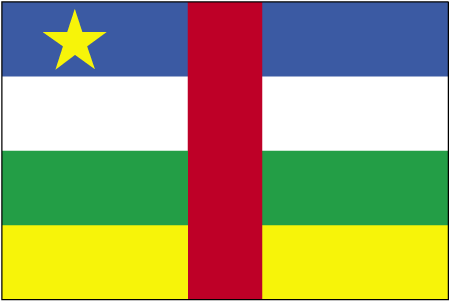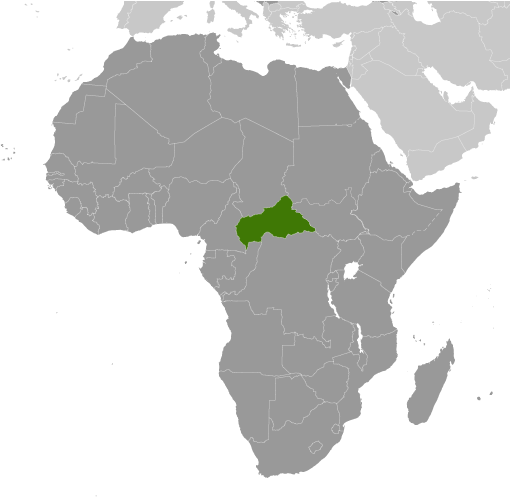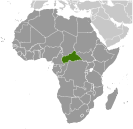
|
|
Advertisements:
People And SocietyNationality
Noun Central African(s)
Adjective Central African Ethnic groups
Baya 33%, Banda 27%, Mandjia 13%, Sara 10%, Mboum 7%, M'Baka 4%, Yakoma 4%, other 2% Languages
French (official), Sangho (lingua franca and national language), tribal languages Religions
Indigenous beliefs 35%, Protestant 25%, Roman Catholic 25%, Muslim 15% Note Animistic beliefs and practices strongly influence the Christian majority Population World Ranking: 117
5,057,208 (July 2012 est.)
Note Estimates for this country explicitly take into account the effects of excess mortality due to AIDS; this can result in lower life expectancy, higher infant mortality, higher death rates, lower population growth rates, and changes in the distribution of population by age and sex than would otherwise be expected Age structure
0-14 years
41% (male 1,021,144/female 1,007,819) 15-64 years 55.3% (male 1,353,600/female 1,382,291) 65 years and over 3.7% (male 73,977/female 111,196) (2011 est.) Median age
Total 19.3 years
Male 18.9 years Female 19.7 years (2012 est.) Population growth rate World Ranking: 42
2.142% (2012 est.)
Birth rate World Ranking: 25
36.13 births/1,000 population (2012 est.) Death rate World Ranking: 7
14.71 deaths/1,000 population (July 2012 est.) Net migration rate World Ranking: 82
0 migrant(s)/1,000 population (2012 est.) Urbanization
Urban population 39% of total population (2010)
Rate of urbanization 2.5% annual rate of change (2010-15 est.) Major cities - population
BANGUI (capital) 702,000 (2009) Sex ratio
At birth 1.03 male(s)/female
Under 15 years 1.01 male(s)/female 15-64 years 0.98 male(s)/female 65 years and over 0.66 male(s)/female Total population 0.98 male(s)/female (2011 est.) Maternal mortality rate World Ranking: 4
890 deaths/100,000 live births (2010) Infant mortality rate World Ranking: 5
Total 97.17 deaths/1,000 live births
Male 105.04 deaths/1,000 live births Female 89.06 deaths/1,000 live births (2012 est.) Life expectancy at birth World Ranking: 216
Total population 50.48 years
Male 49.23 years Female 51.76 years (2012 est.) Total fertility rate World Ranking: 29
4.57 children born/woman (2012 est.) Health expenditures World Ranking: 154
4.3% of GDP (2009)
Physicians density
0.08 physicians/1,000 population (2004) Hospital bed density
1.2 beds/1,000 population (2006) Hiv/aids - adult prevalence rate World Ranking: 16
4.7% (2009 est.)
Hiv/aids - people living with hiv/aids World Ranking: 36
130,000 (2009 est.)
Hiv/aids - deaths World Ranking: 25
11,000 (2009 est.)
Major infectious diseases
Degree of risk Very high
Food or waterborne diseases Bacterial and protozoal diarrhea, hepatitis A, and typhoid fever Vectorborne disease MalariaRespiratory disease Meningococcal meningitis Water contact disease Schistosomiasis Animal contact disease Rabies (2009) Children under the age of 5 years underweight World Ranking: 27
21.8% (2000)
Education expenditures World Ranking: 159
1.3% of GDP (2009)
Literacy
Definition
Age 15 and over can read and write Total population 56%Male 69.3% Female 43.2% (2010 est.) School life expectancy (primary to tertiary education)
Total 7 years
Male 8 years Female 5 years (2009)
Comments
Add a new comment: |
Advertisement
Members area
Central African Republic (Bangui):
 
GPS points from Central African Republic (Bangui)
|
||||||||

 The former French colony of Ubangi-Shari became the Central African Republic upon independence in 1960. After three tumultuous decades of misrule - mostly by military governments - civilian rule was established in 1993 and lasted for one decade. President Ange-Felix PATASSE's civilian government was plagued by unrest, and in March 2003 he was deposed in a military coup led by General Francois BOZIZE, who established a transitional government. Though the government has the tacit support of civil society groups and the main parties, a wide field of candidates contested the municipal, legislative, and presidential elections held in March and May of 2005 in which General BOZIZE was affirmed as president. BOZIZE was reelected in the 2011 elections, which were widely viewed as having gross inaccuracies and discrepancies. The government still does not fully control the countryside, where pockets of lawlessness persist. Militant group Lord's Resistance Army (LRA) continues to affect stability in the Central African Republic as well.
The former French colony of Ubangi-Shari became the Central African Republic upon independence in 1960. After three tumultuous decades of misrule - mostly by military governments - civilian rule was established in 1993 and lasted for one decade. President Ange-Felix PATASSE's civilian government was plagued by unrest, and in March 2003 he was deposed in a military coup led by General Francois BOZIZE, who established a transitional government. Though the government has the tacit support of civil society groups and the main parties, a wide field of candidates contested the municipal, legislative, and presidential elections held in March and May of 2005 in which General BOZIZE was affirmed as president. BOZIZE was reelected in the 2011 elections, which were widely viewed as having gross inaccuracies and discrepancies. The government still does not fully control the countryside, where pockets of lawlessness persist. Militant group Lord's Resistance Army (LRA) continues to affect stability in the Central African Republic as well.